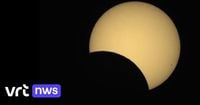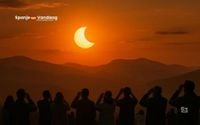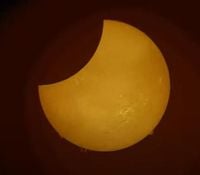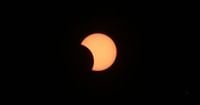A partial solar eclipse captivated viewers across Belgium and parts of Europe on Saturday, March 29, 2025. The phenomenon began at 11:14 AM Belgian time, as the moon gradually moved in front of the sun, creating a spectacular sight for those fortunate enough to witness it. The maximum eclipse occurred at 12:07 PM, when approximately 35 percent of the sun's diameter was obscured, giving the appearance of a large ‘bite’ taken out of the sun.
In Brussels, the eclipse was particularly striking, with 35 percent of the sun covered at its peak. Observers in the western part of Belgium experienced slightly more, with 38 percent obscured, while those in the southeast saw 31 percent of the sun's surface blocked. The event concluded with the moon's last contact with the sun at 1:02 PM, marking the end of the eclipse.
According to Martijn Peters, a science expert, “An eclipse occurs when the moon and the sun align with the Earth. The obscuration is possible because the distance between the Earth and the sun is about 400 times greater than the distance between the Earth and the moon, and the diameter of the sun is about 400 times larger than that of the moon. Because this difference is nearly equal, the celestial bodies appear almost the same size, allowing for an eclipse to be observed.”
This particular eclipse was a partial one, as only the penumbra of the moon touched the Earth, meaning that there was no total solar eclipse visible anywhere in the world. The maximum coverage was notably visible above the Hudson Strait, where approximately 93 percent of the solar surface was covered.
The weather played a crucial role in the visibility of the eclipse. A clear sky allowed many to enjoy the celestial event, which was the first partial solar eclipse visible in Flanders since October 25, 2022. This year’s occurrence was especially significant as it fell on a weekend, enabling more people to participate in the viewing.
To safely observe the eclipse, experts recommended using eclipse glasses, which are about 100,000 times darker than regular sunglasses and made from a special black polymer that blocks harmful UV rays and almost all visible light. For those without eclipse glasses, a simple pinhole projector can be created by making a small hole in a piece of cardboard, allowing sunlight to shine through and project the eclipse onto a surface behind.
As for future opportunities, another partial solar eclipse is scheduled for August 12, 2026, when around 90 percent of the sun will be obscured at approximately 8:00 PM. This event will be particularly spectacular in northern Spain and Portugal, where a total solar eclipse will occur.
In Spain, the eclipse also drew attention, starting around 10:48 AM and peaking at 11:40 AM, with different regions experiencing varying degrees of obscuration. In the northwest, more than 40 percent of the sun was covered, while cities like Madrid, Barcelona, and Valencia saw between 20 and 35 percent obscured. The event concluded around 12:33 PM.
Despite the excitement surrounding the eclipse, it is essential to remember the safety precautions necessary when observing such phenomena. Directly looking at the sun can cause permanent eye damage, and regular sunglasses do not provide adequate protection. Therefore, specialized eclipse glasses or welding goggles with a rating of 14 or higher are recommended for safe viewing.
For many, this was the first opportunity to see a solar eclipse clearly, as such events are infrequent in Spain. The last solar eclipse visible in the country occurred in June 2021. As anticipation builds for the next significant solar event in 2026, many enthusiasts are already planning trips to the best viewing locations.
As the day of the eclipse unfolded, various organizations, including local astronomical societies, opened their doors to the public, providing safe viewing opportunities and educational resources. In Flanders, a campaign was launched to inform schoolchildren about the solar eclipse, allowing them to learn about this fascinating natural phenomenon in a safe environment.
Looking further ahead, the next total solar eclipse in Belgium is not expected until May 25, 2142, when the sun will be completely obscured at around 11:00 AM. Until then, enthusiasts will have to make do with partial eclipses and plan their travels to witness total eclipses in other parts of the world.
As the excitement of March 29 fades, the memories of this partial solar eclipse will linger, a reminder of the beauty and wonder of our celestial neighbors. For those who missed it, the next chance to see a significant eclipse is just around the corner in 2026, making it an event worth marking on the calendar.








